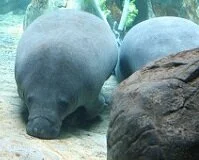Wildlife

Manatee
Panama may not be an incredibly large country, but it contains great diversity in its wildlife. The puma (cougar) and jaguar are among the largest animals, but most of the mammals present are much smaller, like the tapir, monkeys, sloths, anteater, armadillo, and bats. The nearby seas are also teaming with life, from mammals like the manatee and whale to fish and shellfish including rays, sharks, and more.
Many of Panama's birds are either water fowls or woodland birds, including the toucan, macaw, quetzal, and egret. Among the reptiles and amphibians present are crocodiles, turtles, frogs, toads, snakes, and iguanas. Among other animals present are numerous insects and spiders.